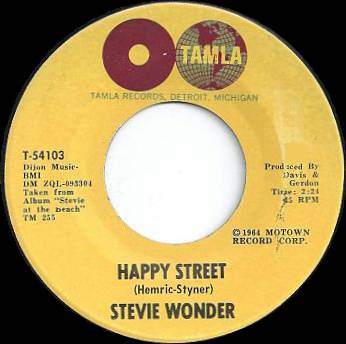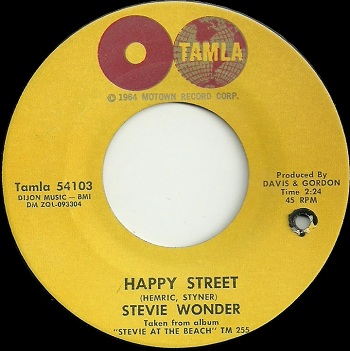Tags
 Tamla T 54103 (A), September 1964
Tamla T 54103 (A), September 1964
b/w Sad Boy
(Written by Guy Hemric and Jerry Styner)
 Even Stevie’s biggest fans have traditionally found it hard to get enthusiastic about his early teenage output, the stuff that comes between mid-1963 and late 1965 – or between Fingertips and Uptight, if you prefer. There are some decent sides in there, but most of it is pretty unimpressive or forgettable fare. On the one hand, you have a record label that didn’t really know what to do with its most precocious talent; on the other hand, you have an artist going through puberty in the public eye and struggling for direction. The “Little Stevie” years were over – Wonder was now a gangly 14-year-old, and his voice was mid-break – but nobody could predict where he was going.
Even Stevie’s biggest fans have traditionally found it hard to get enthusiastic about his early teenage output, the stuff that comes between mid-1963 and late 1965 – or between Fingertips and Uptight, if you prefer. There are some decent sides in there, but most of it is pretty unimpressive or forgettable fare. On the one hand, you have a record label that didn’t really know what to do with its most precocious talent; on the other hand, you have an artist going through puberty in the public eye and struggling for direction. The “Little Stevie” years were over – Wonder was now a gangly 14-year-old, and his voice was mid-break – but nobody could predict where he was going.
This single is a great example of that. Much as with Marvin Gaye’s supper-club cover of Mr Sandman, a similarly-embarrassing early popularity-courting scrawl from another artist who’d later be lauded for his serious, considered, mature work, it’s almost impossible to work out how Stevie got to there from here, because if there’s any single that seems to discount any possibility of its creator becoming one of the greatest artists and writers of all time, it’s Happy Street.
That’s not to say Happy Street is the worst of Stevie’s “awkward years”. It’s soulless and artificial, but it’s not irredeemably awful. It’s just that it’s completely lacking in ambition (and it’s not high on effort, either, which is really surprising.) This is a painstaking recreation of Fingertips, and it’s not surprising to discover it was a product of Hollywood.
Stevie was featured “singing” the song – twice – in the AIP teen vehicle Muscle Beach Party, firstly tearing it up in front of Dick Dale, then dancing, drumming and beating the bongos over the end credits. Everyone in both scenes is miming (observe Dick’s movements!), but they’re not miming to the studio version either time – these are two fresh recordings, made specially for the movie:-
 Previous Motown attempts to recapture lightning in a bottle had been dismal failures – compare the Contours’ increasingly poor efforts to recreate the success of Do You Love Me with a series of forced-fun knockoffs, each missing the point more than the last – and so there was little reason to expect anything different here.
Previous Motown attempts to recapture lightning in a bottle had been dismal failures – compare the Contours’ increasingly poor efforts to recreate the success of Do You Love Me with a series of forced-fun knockoffs, each missing the point more than the last – and so there was little reason to expect anything different here.
Although it is different, obviously. This is another West Coast recording for Stevie; the LA-based writers Hemric and Styner have one previous appearance here on Motown Junkies, penning Joanne and the Triangles’ alarmingly drippy After The Showers Come Flowers; they’d later supply the Supremes with the title track to another AIP vehicle, Dr. Goldfoot and the Bikini Machine (which I’ve already decided must get a review when the time comes!). It’s unlikely, then, that this was Motown making a concerted effort to recreate the success and atmosphere of Stevie’s big breakthrough; far more plausible that this was all done at AIP’s request, that if they were going to have a teenaged Stevie Wonder in their movie, he’d better do something new along the lines of the big hit everyone knew him for.
 Its inclusion on the LP Stevie at the Beach (left) makes perfect sense, and if that’s where it had stayed, fair enough. The album had been in stores for ages by now, and with two singles already pulled from it – Castles In The Sand and Hey Harmonica Man – it was close to being mined out for material. Baffling, then, that Motown somehow decided the time was ripe for a throwback to the frantic days of Little Stevie (as he’s billed in the movie) and chose to sling this out as a single.
Its inclusion on the LP Stevie at the Beach (left) makes perfect sense, and if that’s where it had stayed, fair enough. The album had been in stores for ages by now, and with two singles already pulled from it – Castles In The Sand and Hey Harmonica Man – it was close to being mined out for material. Baffling, then, that Motown somehow decided the time was ripe for a throwback to the frantic days of Little Stevie (as he’s billed in the movie) and chose to sling this out as a single.
The effect of this re-contextualisation is pretty jarring, turning Happy Street from a throwaway piece of beach party film soundtrack filler into the next single from one of Motown’s major artists. Just like on those Contours tracks – Don’t Let Her Be Your Baby is the most egregious example, but there are plenty of others – the magic just isn’t there, and the energy from the original track is gone.
 In its place is a perfunctory and slightly embarrassing exercise in reliving the past, and it doesn’t do anyone any favours – not least Stevie, whose voice is several tones deeper than on Fingertips, but with the added squeaky awkwardness of puberty lurking round every corner. Not only is it the weakest single Stevie Wonder had released since his big breakthrough, it’s also a dead end, giving the public the impression this guy was still the novelty kiddie turn of years past, the tap-dancing, harmonica-blowing blind kid who could whip an audience into a frenzy doing mindless R&B freakouts.
In its place is a perfunctory and slightly embarrassing exercise in reliving the past, and it doesn’t do anyone any favours – not least Stevie, whose voice is several tones deeper than on Fingertips, but with the added squeaky awkwardness of puberty lurking round every corner. Not only is it the weakest single Stevie Wonder had released since his big breakthrough, it’s also a dead end, giving the public the impression this guy was still the novelty kiddie turn of years past, the tap-dancing, harmonica-blowing blind kid who could whip an audience into a frenzy doing mindless R&B freakouts.
Hard to overestimate what that kind of typecasting might potentially have done to Stevie – less of a pigeonhole, and more of a black hole whose sucking gravitational pull he’d find it hard to escape. Nobody at Motown could have known the impressionable 14-year-old would go on to beat the odds and make Talking Book or Innervisions, and – more starkly – the release of this as a single suggests that nobody really believed it either.
Why am I not giving it a worse mark, then? Because it’s still not terrible. Lunkheaded, yes; nakedly, cynically commercial, sure (and wrongly so, too, as this failed to chart); but the harmonica rocks, the writers knew how to get the kids dancing in those movies, and I find myself drumming along to it, every single time. So, even though it’s both stupid and tacky, a pointless step in the wrong direction, I can’t bring myself to hate it, not even a little bit.
MOTOWN JUNKIES VERDICT
(I’ve had MY say, now it’s your turn. Agree? Disagree? Leave a comment, or click the thumbs at the bottom there. Dissent is encouraged!)
You’re reading Motown Junkies, an attempt to review every Motown A- and B-side ever released. Click on the “previous” and “next” buttons below to go back and forth through the catalogue, or visit the Master Index for a full list of reviews so far.
(Or maybe you’re only interested in Stevie Wonder? Click for more.)
 |
 |
| The Velvelettes “Should I Tell Them” |
Stevie Wonder “Sad Boy” |
DISCOVERING MOTOWN |
|---|
Like the blog? Listen to our radio show! |
| Motown Junkies presents the finest Motown cuts, big hits and hard to find classics. Listen to all past episodes here. |


Hey, even Eleanor Roosevelt once did a margarine commercial. And David O. Selznick didn’t make “Gone With The Wind” every time out. Sometimes it’s just about paying the bills.
I found my 45 of this on October 21, 1978 in either Deptford Mall or Echelon Mall Record Museums (both in southern New Jersey). I would no more have left it in the bins than, say, The Supremes’ “My Heart Can’t Take It No More.” By then I knew what the great ones weren’t and the purchases were about filling holes in their discographies. (Still couldn’t resist added copies of the greats though either, which is how I would up with seven “Where Did Our Love Go’s”.)
Like you, though, I don’t hate it either. It’s rather silly and childish but at least its energetic. I’d rather listen to Stevie doing “Happy Street” a half-dozen times in a row, than Marvin doing “If My Heart Could Sing” even twice. The same is true of “Kiss Me Baby,” even though I can’t think of a line of lyrics from it at this moment.
“Uptight” is considered the adult breakthrough, but the kick-ass, live “High Heel Sneakers” which immediately precedes it, I’m every bit as fond of. Like the treacherous road from Munchkinland to Emerald City, real Stevie fans know the trail from “Workout” to “Sneakers” is going to be a bumpy one, but don’t approach with it with hopelessness, because Wonder the Wizard is waiting at the end.
LikeLiked by 1 person
I would love to see this Eleanor Roosevelt commercial (LOL).
LikeLike
(The other video I just posted below is rather more engaging.)
LikeLike
Wow! Thanx for posting. So weird to see the former first lady talking about margarine (LOL).
LikeLike
This movie actually came on a few nights ago on TV. How cool is that?!? (LOL).
Anyhow this song isn’t the greatest, but I did find myself snapping my fingers to it when it came on doing the movie. Once I heard it again, this time just the song, it had a Sesame Street vibe to it. I began singing “Want you tell me how to get to Sesame Street” (LOL). That’s never a good thing, so this song deserves its 3/10.
Mr. Nixon great job on the analysis of Little Stevie. When certain people become “icons” the public tends to forget their early struggle and lost of direction.
LikeLike
🙂 Don’t be so quick to write off the combination of Stevie Wonder and Sesame Street, seeing as how it gave us THIS:
(check out the kid in red on the stairwell absolutely going for it!)
LikeLike
(Everyone probably thought I was going to post this clip from the same episode, a song Stevie apparently made up on the spot, but the sound/video quality isn’t as good):
LikeLike
Now when I said “Happy Street” reminded me of Sesame Street I definitely wasn’t talkin about THIS Sesame Street (LOL). Funky! I like this better than “Happy Street”
= )
LikeLike
= ) Thanx for showing me this! I had no idea about it. That’s why I love this site. I would’ve been just like the kid in the stairwell! (LOL)
LikeLike
Can you imagine this happening today?
(Scene: Children’s Television Workshop offices)
STUDIO EXECUTIVE: Sorry, I still don’t quite understand… what did you want to do?
DRAKE: I want to perform my new single on Sesame Street.
STUDIO EXECUTIVE: I mean, we’re pleased you’re interested, but…
DRAKE: And I want to do it live, with an eleven-piece band of stoned-looking dudes. And they have to be LOUD, you know?
STUDIO EXECUTIVE: It’s just, I’m not quite sure whether it’s really appropriate for the kids…
DRAKE: And I’m going to extend it to twice its normal running time – say, seven minutes or so – and end it in a crazy funk-soaked freakout. That sound good to you?
STUDIO EXECUTIVE: Um… what?
DRAKE: I’m also going to write you a new song where I burble into a vocoder for two minutes. And I’d also like to do a skit with Elmo, if there’s time.
STUDIO EXECUTIVE: O-kayy. Er, I tell you what, I’ll call you.
DRAKE: Cool. Have your people call my people. Let’s do this!
(Drake leaves)
STUDIO EXECUTIVE: (into intercom) Berenice, if Drake calls again, please tell him I’m in a meeting.
LikeLike
(LOL) Yep! Or what about the controversy Katy Perry caused when she was suppose to appear on Sesame Street? SMH. If Debbie Harry appeared on Sesame Street and did not cause any controversy any female artist should. LOL.
LikeLike
Although it sounded okay, and I like it more than most of Stevie’s post 1968 cuts, I still don’t understand why they released this as a single (passing quality control), and, yet, 54108, Stevie’s “Pretty little Angel” (my all-time favourite cut of his) was re-called-(never really released). “Happy Street” was basically the same song as several of “Liitle” Stevie’s harmonica solo rhythmic singles.
LikeLike
I heard “Pretty Little Angel” for the first time and it is a great record. Thanx!
LikeLike
I forgot to mention yesterday how adorable the “Stevie at the Beach” album cover is (LOL).
LikeLike
R.I.P. Annette Funicello —
LikeLike